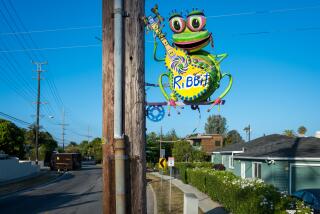Sam Francis Foundation sues nine galleries for artists’ royalties
For decades, gallery owners in California have wished that the state’s Resale Royalty Act of 1976, which provides artists with 5% of the sales price of artworks when they are resold under certain conditions, would just go away. While some dealers follow the law and pay the royalty to artists, others do not.
But it’s hard to track what artists may be owed in either case, given the difficulty of getting the galleries to disclose information on their sales.
Now, working to force some disclosures as well as recover money, the foundation of the late abstract painter Sam Francis is the lead plaintiff in class-action lawsuits filed Tuesday against nine galleries in Northern and Southern California. The complaints, alleging that these galleries “failed and refused” to pay the royalty to the foundation, were filed in Los Angeles and San Francisco Superior Courts by Los Angeles attorney Eric George, who last month filed class-action suits against Sotheby’s and Christie’s in New York and EBay in San Jose citing the same law.
Together, these suits represent the most serious attempt yet to put teeth in a law that experts say is little publicized, rarely enforced and virtually untested in the courts.
It’s a law whose very constitutionality is a matter of debate: Some experts think California’s law requiring a royalty for visual artists conflicts with the federal Copyright Act of 1976.
The galleries sued this week include some of the state’s busiest galleries specializing in what are known as secondary-market sales: Ace, Manny Silverman, Leslie Sacks, Hamilton/Selway, Denis Bloch and Lora Schlesinger galleries in Los Angeles, and Scott Richards, Martin Lawrence and Hackett/Mill in San Francisco.
George expects that other artists or their estates could come forward. “There’s a good possibility that we will name additional galleries as defendants,” he said.
“There are very few galleries that comply with the resale royalty requirement. For every one instance where I hear about an artist receiving a royalty payment, I hear 10 stories of artists who have not,” George said.
The law provides that artists or their heirs receive a 5% royalty on certain resale transactions provided that the sale takes place in California or that the seller resides in California. The law applies only to the sale of fine art, defined as an “original painting, sculpture, or drawing, or an original work of art in glass” that sells for more than $1,000. The 5% is taken from the sale price, not the profit. These rights under the law extend to artists’ heirs for up to 20 years after the artist’s death.
Debra Burchett-Lere, the head of the Sam Francis Foundation, which was created after the artist’s death in 1994, declined to comment on the lawsuits.
Some of the galleries sued also declined to comment, saying that they hadn’t consulted their attorneys. But others did respond. Lora Schlesinger said, “I always pay [the royalty] to artists when I sell something for them. I didn’t know it applied to artists who are no longer living.”
Doug Chrismas of Ace Gallery said, “I don’t think I’ve been involved in the resale of a Sam Francis from the secondary market. All of the works we’ve sold were purchased directly from Sam or his estate.”
Denis Bloch said, “I don’t see a reason for me to be sued by the foundation — I sell prints. Never in my life have I sold an ‘original’ Sam Francis painting.”
“This is news to us,” said John Obrecht, managing director of Hackett/Mill. “Hackett/Mill has not even sold a Sam Francis. I think we’ll be able to move through this fairly easily. I think they threw a big net to see what they would catch.”
George said he based his investigation, in the absence of access to gallery receipts or invoices, on “the websites of the galleries, third party websites such as artnet.com, and conversations with artists and artists representatives.” The complaints do not provide specific examples of resales, titles of artworks or prices.
California is the only state with a resale royalty for visual artists. Artist Robert Rauschenberg, state Sen. Alan Sieroty and an artists rights group called Artists for Economic Action all lobbied for the bill, which Gov. Jerry Brown signed into law in 1976. The intention was for artists to participate in the financial appreciation of their own artwork, as artists in France do under the “droit de suite.” Similar bills in other states have failed to gain support.
Los Angeles art law attorney Christine Steiner calls the California law “an obscure act more honored in the breach than the observance, meaning that more people seem to deal with it by not following it than following it.”
She points to several reasons why the law is controversial, from the “burden it places on California trade” to questions about its constitutionality.
Earlier this year, a federal judge considering a lawsuit filed by artist Mark Grotjahn ruled that the state law does not conflict with the federal Copyright Act of 1976 or otherwise violate the Constitution. But Steiner thinks the issue is far from resolved. “I teach an art law seminar at Loyola, and one of the things we discuss all the time is the constitutionality of this law. I think it will be interesting to see how this issue figures into [future] defenses,” she said.
Nobody will hazard a guess at the volume of resale business that falls under the law today. But more than a dozen California gallery owners not named in these suits, speaking last month on condition of anonymity, said that they hope the statute is not upheld. They said that if it were enforced, it could have a chilling effect on secondary-market art sales in California, driving business to galleries in other states. Several dealers also identified the 5% royalty as one reason why contemporary art auctions have failed to flourish in the state despite efforts over the years by the major auction houses.
Many artists, for their part, don’t know their full rights under the law. The law requires that the seller or “the seller’s agent” pay the royalty directly to the artist, or deposit the money with the California Arts Council if the artist can’t be located. According to its “resale royalty coordinator,” Patricia Milich, the council has collected slightly more than $325,000 on behalf of 400 artists — the royalties on about $6.5 million worth of art sales — since 1977.
When artists can’t be located after seven years, the money goes to the state’s Art in Public Places Program. Nearly $50,000 has gone that route.
Painter Rebecca Campbell said she knows about the law because her gallery, L.A. Louver, “is so [on the] up and up that they tell me about everything.” She says she has received two royalty checks from them.
Painter Lari Pittman recently received checks from his gallery, Regen Projects, on the resale of “four or five drawings” but added, “I think they are an anomaly. Because I have a somewhat active resale market, I also know of certain galleries who have maybe resold my pieces and I have not received anything from them.”
An artist as successful as Mark Bradford said he didn’t know about the law until a dealer mentioned it to him a month ago. He says he has never received a royalty from a gallery or from the New York auction houses, where he has had nearly a dozen paintings sell for six-figure prices in the last decade.
“My gallery doesn’t hold anything back from me, but you never really know — suddenly a work of mine will go to auction, for example,” Bradford said. He described the art market as “still pretty much smoke and mirrors for the artists.”
More to Read
The biggest entertainment stories
Get our big stories about Hollywood, film, television, music, arts, culture and more right in your inbox as soon as they publish.
You may occasionally receive promotional content from the Los Angeles Times.











